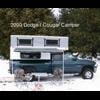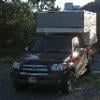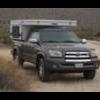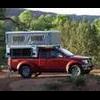
water lines in winter
Started by
benburnett
, Oct 01 2007 03:23 PM
16 replies to this topic
#11

Posted 03 October 2007 - 02:32 AM
Thanks for all the input. I talked to Jeff also who used to do a lot of cold weather camping and he claims that he never had a system freeze up on him. In extreme cold he would leave the heater running on low to prevent any freeze up also.
#12

Posted 03 October 2007 - 11:41 PM
Is this it? DECKER'S proudly offers the famous "R&M SPECIALTY PRODUCTS" vehicle mounted camping shower system.
Mike
That looks like the one.
#13

Posted 05 October 2007 - 10:05 PM
Disposable water jugs in various sizes is how the folks in small trailers also deal with winter camping, with the rest of the system winterized.
#14

Posted 16 October 2008 - 08:59 PM
I did a search for winterizing the water system in my Hawk and only came up with this thread.
If anyone has done this a few times I'd appreciate ya looking over this small check list to see if I forgot anything....
Drain main water tank (parked on a nice hill)
Propane off to Hot water heater/tank
Removed Anode and drained the Hot Water tank
Opened gray water drain, just in case
ran faucet pump dry
Made nifty cover for inside of HWC cover panel to keep road grime/ice out
what'd I forget? Will the sink pump be OK just draining the system or should I remove it altogether? (probably easier said than done)
tricks or tips appreciated. I'll be taking the unit off'/storing it in the garage after a trip to New Mexico in late Nov. but we're already below freezing @ night here so I want to fully winterize it until Summer. (up until today I had a dropcord/100 watt lamp in the cabinet and it stayed toasty/kept it from freezing)
thanks for any help
mtn
If anyone has done this a few times I'd appreciate ya looking over this small check list to see if I forgot anything....
Drain main water tank (parked on a nice hill)
Propane off to Hot water heater/tank
Removed Anode and drained the Hot Water tank
Opened gray water drain, just in case
ran faucet pump dry
Made nifty cover for inside of HWC cover panel to keep road grime/ice out
what'd I forget? Will the sink pump be OK just draining the system or should I remove it altogether? (probably easier said than done)
tricks or tips appreciated. I'll be taking the unit off'/storing it in the garage after a trip to New Mexico in late Nov. but we're already below freezing @ night here so I want to fully winterize it until Summer. (up until today I had a dropcord/100 watt lamp in the cabinet and it stayed toasty/kept it from freezing)
thanks for any help
mtn
#15

Posted 16 October 2008 - 09:10 PM
Here are the basic we have listed in the owners manual ...
Winterizing the Hot Water / Outdoor Shower System:
To reduce the possibility of fractures and splits in the system's water tanks, lines, and pressurizing pump in climates where the temperature is below freezing (32 degrees F; 0 degrees C), it is recommended that as much water as possible be drained from the system, or you can add a mixture of water and non-toxic antifreeze to the campers water system (Please contact the companies at the bottom of this page for more info regarding non-toxic antifreeze, mixture ratio, and important safety info). If your camper is equipped with the “Hot Water Heater”, it is NOT recommended that you use anti-freeze in the campers water system unless you remove the anode rod and replace it with a ¾” drain plug.
* CAUTION – BE SURE TO RELEASE THE WATER PRESSURE
IN THE HOT WATER TANK BEFORE YOU REMOVE THE ANODE ROD !
1. Drain the Hot Water Tank:
Drain the Hot Water Heater 3 or 4 Gallon Hot Water Tank by removing the Hot Water Tank Drain Plug (Anode Rod). This plug is located on the center of the bottom of the hot water tank in the Hot Water Heater Compartment. It is accessed by removing the Hot Water Heater Access Panel on the exterior wall. Remove the Hot Water Tank Drain Plug (Anode Rod). After water stops flowing from the Hot Water Tank Drain Plug Port, replace the drain plug.
When you remove the drain plug from your water heater, you will see an anode rod attached to it. The anode will probably look corroded and eaten away, but that’s the purpose it serves so don’t worry about that. Annually, or when the rod has eroded away to about a quarter of its original size, replace it. Simply unscrew the drain plug and screw in a new one.
Suburban water heaters feature an anode rod. The anode equalizes aggressive water action, providing cathodic protection for the tank. It is a very important factor in tank life and should only be removed for inspection, draining or replacement. It is removable using a 1-1/16" socket.
All Suburban water heaters are protected by a magnesium or aluminum anode to prolong the life of the tank. Under normal use, the anode rod will deteriorate. Because of this, we recommend it be replaced annually or when consumption or weight loss of the rod is greater than 75%. Note: Water with high levels of iron and/or sulfate will increase the rate of deterioration. To extend anode life, drain water from tank whenever the RV is not being used. Avoid any extended time of non-use with water in the tank.
* IMPORTANT HOT WATER TANK NOTES
Drain the water heater completely, particularly if you are introducing antifreeze into the plumbing system. Antifreeze can be very corrosive to the anode rod inside of the hot water heater. The result will be accelerated deterioration of the rod and heavy sediment in the tank. If you intend to winterize by adding antifreeze into the system, remove the anode rod from the tank (storing it for the winter) and replace it with a 3/4" drain plug.
2. Drain the Shower Head and Hose:
Open the door to the Outdoor Hot Water Shower Compartment near the rear of the camper on the driver's side. Remove the shower head and hose. Extend the hose until it is straight. With the hose straightened, position the showerhead so that it is lower than where the hose is attached to the shower compartment. Turn on both the cold and hot water valves until the water stops flowing from the showerhead. Close the water valves.
3. Drain the 20 Gallon Freshwater Tank and Drain Line:
The 20 Gallon Freshwater Reservoir, located under the camper's front seat, and its drain line are drained at the drain valve located on the driver's side rear exterior wall near the camper entry door, open the valve and leave it open.
4. Drain the Water Pump:
Run the Water Pump for approximately 15 to 30 seconds or as long as water is flowing from the sink faucet with both the hot and cold water valves opened to drain as much remaining water from the system as possible. Turn the water pump off, and leave both water valves open so that any excess water that might freeze, will have room for expansion (instead of cracking a water line).
5. Add Non-Toxic Antifreeze
Add the correct amount of properly prepared non-toxic RV Antifreeze and water solution to the Freshwater Reservoir at the Potable Water Port on the driver's side of the camper. See antifreeze manufacturer's mixture recommendations.
Run the system water pump until antifreeze/water mixture flows from the sink faucet and showerhead. Close all valves.
Stow the showerhead and hose to the Outdoor Hot Water Shower Compartment.
Drain the sink and replace the cap on the sink's gray water spout.
Before refilling the camper's 20 Gallon Freshwater System and 3 Gallon Hot Water Tank with fresh/potable water, thoroughly flush the entire system with the pressurizing pump running, to remove the antifreeze.
.
Winterizing the Hot Water / Outdoor Shower System:
To reduce the possibility of fractures and splits in the system's water tanks, lines, and pressurizing pump in climates where the temperature is below freezing (32 degrees F; 0 degrees C), it is recommended that as much water as possible be drained from the system, or you can add a mixture of water and non-toxic antifreeze to the campers water system (Please contact the companies at the bottom of this page for more info regarding non-toxic antifreeze, mixture ratio, and important safety info). If your camper is equipped with the “Hot Water Heater”, it is NOT recommended that you use anti-freeze in the campers water system unless you remove the anode rod and replace it with a ¾” drain plug.
* CAUTION – BE SURE TO RELEASE THE WATER PRESSURE
IN THE HOT WATER TANK BEFORE YOU REMOVE THE ANODE ROD !
1. Drain the Hot Water Tank:
Drain the Hot Water Heater 3 or 4 Gallon Hot Water Tank by removing the Hot Water Tank Drain Plug (Anode Rod). This plug is located on the center of the bottom of the hot water tank in the Hot Water Heater Compartment. It is accessed by removing the Hot Water Heater Access Panel on the exterior wall. Remove the Hot Water Tank Drain Plug (Anode Rod). After water stops flowing from the Hot Water Tank Drain Plug Port, replace the drain plug.
When you remove the drain plug from your water heater, you will see an anode rod attached to it. The anode will probably look corroded and eaten away, but that’s the purpose it serves so don’t worry about that. Annually, or when the rod has eroded away to about a quarter of its original size, replace it. Simply unscrew the drain plug and screw in a new one.
Suburban water heaters feature an anode rod. The anode equalizes aggressive water action, providing cathodic protection for the tank. It is a very important factor in tank life and should only be removed for inspection, draining or replacement. It is removable using a 1-1/16" socket.
All Suburban water heaters are protected by a magnesium or aluminum anode to prolong the life of the tank. Under normal use, the anode rod will deteriorate. Because of this, we recommend it be replaced annually or when consumption or weight loss of the rod is greater than 75%. Note: Water with high levels of iron and/or sulfate will increase the rate of deterioration. To extend anode life, drain water from tank whenever the RV is not being used. Avoid any extended time of non-use with water in the tank.
* IMPORTANT HOT WATER TANK NOTES
Drain the water heater completely, particularly if you are introducing antifreeze into the plumbing system. Antifreeze can be very corrosive to the anode rod inside of the hot water heater. The result will be accelerated deterioration of the rod and heavy sediment in the tank. If you intend to winterize by adding antifreeze into the system, remove the anode rod from the tank (storing it for the winter) and replace it with a 3/4" drain plug.
2. Drain the Shower Head and Hose:
Open the door to the Outdoor Hot Water Shower Compartment near the rear of the camper on the driver's side. Remove the shower head and hose. Extend the hose until it is straight. With the hose straightened, position the showerhead so that it is lower than where the hose is attached to the shower compartment. Turn on both the cold and hot water valves until the water stops flowing from the showerhead. Close the water valves.
3. Drain the 20 Gallon Freshwater Tank and Drain Line:
The 20 Gallon Freshwater Reservoir, located under the camper's front seat, and its drain line are drained at the drain valve located on the driver's side rear exterior wall near the camper entry door, open the valve and leave it open.
4. Drain the Water Pump:
Run the Water Pump for approximately 15 to 30 seconds or as long as water is flowing from the sink faucet with both the hot and cold water valves opened to drain as much remaining water from the system as possible. Turn the water pump off, and leave both water valves open so that any excess water that might freeze, will have room for expansion (instead of cracking a water line).
5. Add Non-Toxic Antifreeze
Add the correct amount of properly prepared non-toxic RV Antifreeze and water solution to the Freshwater Reservoir at the Potable Water Port on the driver's side of the camper. See antifreeze manufacturer's mixture recommendations.
Run the system water pump until antifreeze/water mixture flows from the sink faucet and showerhead. Close all valves.
Stow the showerhead and hose to the Outdoor Hot Water Shower Compartment.
Drain the sink and replace the cap on the sink's gray water spout.
Before refilling the camper's 20 Gallon Freshwater System and 3 Gallon Hot Water Tank with fresh/potable water, thoroughly flush the entire system with the pressurizing pump running, to remove the antifreeze.
.
Stan Kennedy --- Four Wheel Pop-up Campers
1400 Churchill Downs Avenue, Suite A
Woodland, CA 95776
(800) 242-1442 or (530) 666-1442
www.fourwh.com --- e-mail = stan@fourwh.com
#16

Posted 16 October 2008 - 11:08 PM
I better do something quick as it will be 40 - 50 below zero here real quick..
robbie
robbie
#17

Posted 18 October 2008 - 03:08 PM
Mtn,
What kind of cover did you make for the HWC cover panel?
What kind of cover did you make for the HWC cover panel?
Made nifty cover for inside of HWC cover panel to keep road grime/ice out
mtn
Rick
2007 Nissan Frontier King Cab 4x4 NISMO. Ride-Rite air bags.
2008 Eagle
0 user(s) are reading this topic
0 members, 0 guests, 0 anonymous users
















